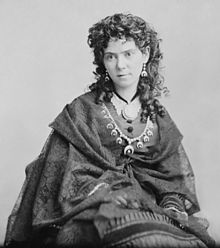Vinnie Ream
Lavinia Ellen Ream (born September 25, 1847 in Madison , Wisconsin , † November 20, 1914 in Washington, DC ) was a well -known American sculptor .
Life
Lavinia Ellen, called Vinnie , was the youngest daughter of three children of German-born land surveyor and government employee Robert Lee Ream and his wife Lavinia McDonald, whose ancestors came from Scotland . While in Wisconsin she was introduced to painting and drawing by Winnebago Indians . In 1856 the family moved to Missouri , where they attended Columbia College of Missouri Girls' College in Columbia . Here her teachers recognized Vinnie's artistic talents; she received guitar and harp lessons . In addition, Vinnie wrote songs and performed on stage. When the American Civil War broke out , the family moved to Washington and Vinnie found a job in the Capitol Post Office. It was here in 1863 that she met the sculptor Clark Mills, who had his studio in a wing of the Capitol, and was a model for him . A short time later, Vinnie began training with him as a sculptor. In the months that followed, she worked with Mills to create busts of Congressmen and other notable figures, including John Sherman , George Armstrong Custer , David Glasgow Farragut , Francis Blair , Thaddeus Stevens, and Horace Greeley .
In the second half of 1864, President Abraham Lincoln was her model for a bust. The bust took a full five months to complete, as the President was only available for the meeting for half an hour a day. Shortly after the completion of Lincoln was on the evening of April 14, 1865 while visiting the Ford Theater in Washington by a fanatical supporters of the southern states , the actor John Wilkes Booth , shot. The next day he died from severe head injuries. In the summer of 1866, Congress placed a $ 10,000 contract to create a marble statue of the murdered president. The commission went to the 19-year-old artist, she was the only sculptor who had modeled the president during his lifetime. Critical voices were the part of the widow, Mary Todd Lincoln, and the journalist Jane Swisshelm who wrote that Vinnie's success only on the use of female lists ( feminine wiles based). The contract was signed on August 30, 1866.
After suffering from scarlet fever , Vinnie Ream traveled to Italy with her parents , where she studied at the sculpture academy in Carrara under the well-known sculptor Luigi Majoli. In the Carrara quarries, she decided to use their marble blocks for the Lincoln statue. The statue was completed in Italy and, upon the return of the Ream family to the United States, in the presence of President Ulysses S. Grant and numerous other dignitaries, was ceremonially unveiled in Washington on January 25, 1871.
On May 28, 1878, Vinnie Ream married Lieutenant Richard Leveridge Hoxie, later brigadier general and chief of the United States Army Corps of Engineers, in Washington . The incumbent President was also present at the celebrations. The mutual connection resulted in a son, Richard Jr. (* 1883). In the following years, Vinnie Hoxie rose to become the grande dame of Washington society . She did not return to her studio until 1906 to work on the statue of Samuel Jordan Kirkwood . Her last work was a commission from the US state of Oklahoma for a statue of Sequoyah , the creator of the Cherokee script .
Vinnie Ream Hoxie died on November 20, 1914 of complications from kidney failure in her family's circle and was buried in Arlington National Cemetery in Washington. Her husband had a copy of the bronze statue of the Greek poet Sappho she designed as a tombstone.
Portraits and works (selection)
Edwin B. Haye, 1906, Washington, DC
literature
- Dawn FitzGerald: Vinnie and Abraham , (2007) ISBN 978-1-57091-658-8
- Edward S. Cooper: Vinnie Ream: An American Sculptor , Academy Chicago Pub Ltd (2004) ISBN 0-89733-505-8
- Maureen Stack Sappey: Letters from Vinnie , Front Street (1999) ISBN 1-886910-31-6
- Glenn V. Sherwood: A Labor of Love: The Life & Art of Vinnie Ream , SunShine Press Publications (1997) ISBN 0-9615743-6-4
Web links
- Vinnie Ream (English)
- Vinnie Ream Hoxie (English)
- Vinnie Ream Hoxie (English)
- Vinnie Ream Hoxie (English)
Remarks
- ↑ John Ream's Family Homepage, http://www.johnream.com/vinnie.htm , et al.
- ^ Arlington National Cemetery Website, http://www.arlingtoncemetery.net/vrhoxie.htm
- ^ Arlington National Cemetery Website, http://www.arlingtoncemetery.net/vrhoxie.htm
| personal data | |
|---|---|
| SURNAME | Ream, Vinnie |
| ALTERNATIVE NAMES | Ream, Lavinia Ellen |
| BRIEF DESCRIPTION | American sculptress |
| DATE OF BIRTH | September 25, 1847 |
| PLACE OF BIRTH | Madison , Wisconsin |
| DATE OF DEATH | November 20, 1914 |
| Place of death | Washington, DC |








